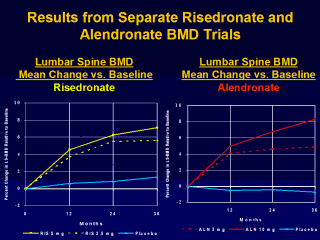 Reginster (VERT-MN)
Liberman (Combined U.S. and Multinational)
Reginster (VERT-MN)
Liberman (Combined U.S. and Multinational) |
Data
are from separate placebo-controlled clinical trials. These are not head-to-head trials in
the same patient population, and therefore cannot be used to compare clinical
efficacy. You may have heard about (or seen)
comparative slides of Fosamax and Actonel BMD results (origin of slides is not clear).
You should know that such
comparisons are inappropriate and misleading, since head-to-head studies have not been
conducted.
We have heard the slides
show the best 3 year BMD data for Fosamax (Liberman, ~9%) versus 2 year preliminary BMD
data from an early Actonel study (Fogelman abstract, ~4%). This is clearly not an
apples-to-apples comparison.
In this slide we try to
present an apples-to-apples look at lumbar spine BMD from VERT-MN and Liberman studies.
Note, the results are presented versus baseline. This is important, because the placebo
group in Actonel studies gained significant BMD (1,000 mg calcium) and the placebo group
in Liberman study tended to lose BMD (500 mg calcium). Thus, a comparison vs. placebo
would underestimate Actonel results and overestimate Fosamax results.
Our conclusion is that
both BPs build significant BMD at key sites.
However, we feel BMD is
only surrogate marker of efficacy now that results from fracture studies are available.
This even more important given the new understanding that there is not a linear
relationship between BMD and fracture reduction with antiresorptive therapies. |
 Reginster (VERT-MN)
Liberman (Combined U.S. and Multinational)
Reginster (VERT-MN)
Liberman (Combined U.S. and Multinational)